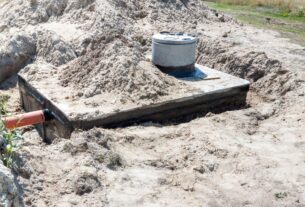As winter approaches, it’s important to prepare your lawn for the colder months ahead. Proper winter lawn care ensures that your grass stays healthy and vibrant, ready to thrive when spring arrives. In this comprehensive guide, we will explore the essential steps to putting your lawn to bed for winter, providing you with the knowledge you need to maintain a beautiful and resilient lawn throughout the year.
Page Contents
Last Cut and Equipment Maintenance
Before winter sets in, make sure to give your lawn one final trim. Leaving the grass a little longer helps protect the roots during the colder months. Additionally, it’s crucial to maintain your lawn equipment, such as your mower. Clean the mower deck, sharpen the blades, and lubricate the necessary parts. By doing so, you ensure that your equipment remains in optimum condition for the upcoming spring season.
Winter Fertilizer for Added Protection
Grass plants store vital nutrients in their roots during the winter months. Applying a high-quality winter fertilizer will enhance your lawn’s ability to withstand snow mold and winter kill. This additional nourishment boosts the strength of the grass, allowing it to resist diseases better. Remember, while the results may not be immediately visible, you can rest assured that they will become evident come spring when your lawn showcases a vibrant and robust appearance.
Thickening Your Lawn through Overseeding
Fall is the ideal time to consider overseeding your lawn, benefiting from the favorable growing conditions. Rake the lawn thoroughly with a fan rake to remove any dead grass, leaves, or debris, ensuring direct contact between the soil and seeds for proper germination. When sowing seed in bare patches, be generous but mindful not to waste the seeds. The cool daytime temperatures and heavy morning dew during fall provide optimal conditions for germination and establishment.
Planting New Lawn for a Lush Green Transformation
If you have areas of bare ground that you want to transform into a lawn, fall is an excellent time to embark on this project. Prepare the ground by adding a top layer of triple mix, a nutrient-rich soil, a few centimeters deep. This layer will provide essential nourishment for the grass as it takes root, ensuring a healthy and thriving lawn.
Aeration for Soil Health
Another crucial step in preparing your lawn for the winter is to aerate it. The compacted soil in your lawn reduces its ability to absorb all the necessary nutrients and water that it needs. Aeration involves perforating the soil with small holes to allow air, water, and nutrients to penetrate the grass roots easily. You can use a manual aerator or a machine to carry out the aeration process. It is ideal to aerate in late fall to revive the lawn from the rigours of summers and prepare it for the harsh winter months ahead.
Rake Leaves and Remove Debris
As autumn comes to an end, the trees start shedding their leaves, and the debris from the surrounding area may begin to accumulate on your lawn. It’s essential to rake the leaves and remove other debris from the grass as they can block the sun and trap moisture, promoting fungal growth in your lawn. Neglecting to take this essential step could lead to a mat of smothered grass and insect populations, making it harder to restore your lawn in the spring. A thorough cleaning of your lawn helps reduce the risk of honeydew buildup, which invites fungi and other pests.
Proper Watering Techniques
Even as the temperatures start to drop, it’s crucial to keep your lawn hydrated. While naturally occurring rainwater may be sufficient, you may need to supplement the water your lawn receives with a comprehensive watering schedule. It’s best to water your lawn deeply and less frequently in preparation for winter. Winterizing your irrigation system using a sprinkler blowout is essential to prevent cracking due to freezing water. Leaving water in sprinklers can also lead to the growth of ice blocks, which can further damage the equipment.
Get in Touch With Expert Lawn Care Professionals
Putting your lawn to bed for the winter takes time, effort, and a little bit of know-how. By following the tips outlined in this comprehensive guide, you can prepare your lawn to withstand the colder temperatures and get it ready for spring. With the right winter lawn care, you can look forward to a lush, vibrant lawn that’s prepared to take on the summer months ahead. Don’t forget to contact professional lawn care experts for additional assistance in matters related to lawn care.

Lois Lane is a professional blogger and a seasoned Content writer for wellhousekeeping.com. With a passion for simplifying complex Home Decor topics, he provides valuable insights to a diverse online audience. With four years of experience, Lois has polished his skills as a professional blogger.




